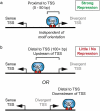Transcribe this way: Rap1 confers promoter directionality by repressing divergent transcription
- PMID: 31057041
- PMCID: PMC6602560
- DOI: 10.1080/21541264.2019.1608716
Transcribe this way: Rap1 confers promoter directionality by repressing divergent transcription
Abstract
In eukaryotes, divergent transcription is a major source of noncoding RNAs. Recent studies have uncovered that in yeast, the transcription factor Rap1 restricts transcription in the divergent direction and thereby controls promoter directionality. Here, we summarize these findings, propose regulatory principles, and discuss the implications for eukaryotic gene regulation.
Keywords: Rap1; directionality; divergent; noncoding RNA; promoter; repression; steric hindrance; transcription factor; yeast.
Figures


Similar articles
-
Repression of Divergent Noncoding Transcription by a Sequence-Specific Transcription Factor.Mol Cell. 2018 Dec 20;72(6):942-954.e7. doi: 10.1016/j.molcel.2018.10.018. Mol Cell. 2018. PMID: 30576656 Free PMC article.
-
Identification of a transcriptional activation domain in yeast repressor activator protein 1 (Rap1) using an altered DNA-binding specificity variant.J Biol Chem. 2017 Apr 7;292(14):5705-5723. doi: 10.1074/jbc.M117.779181. Epub 2017 Feb 14. J Biol Chem. 2017. PMID: 28196871 Free PMC article.
-
Chromatin Fiber Invasion and Nucleosome Displacement by the Rap1 Transcription Factor.Mol Cell. 2020 Feb 6;77(3):488-500.e9. doi: 10.1016/j.molcel.2019.10.025. Epub 2019 Nov 21. Mol Cell. 2020. PMID: 31761495 Free PMC article.
-
The multifunctional transcription factor Rap1: a regulator of yeast physiology.Front Biosci (Landmark Ed). 2016 Jun 1;21(5):918-30. doi: 10.2741/4429. Front Biosci (Landmark Ed). 2016. PMID: 27100480 Review.
-
Beyond interacting with Rap1: Dissecting the roles of Rif1.Int J Biol Macromol. 2025 May;306(Pt 3):141560. doi: 10.1016/j.ijbiomac.2025.141560. Epub 2025 Mar 1. Int J Biol Macromol. 2025. PMID: 40032092 Review.
Cited by
-
Strand asymmetries across genomic processes.Comput Struct Biotechnol J. 2023 Mar 11;21:2036-2047. doi: 10.1016/j.csbj.2023.03.007. eCollection 2023. Comput Struct Biotechnol J. 2023. PMID: 36968020 Free PMC article. Review.
-
Unwrap RAP1's Mystery at Kinetoplastid Telomeres.Biomolecules. 2024 Jan 4;14(1):67. doi: 10.3390/biom14010067. Biomolecules. 2024. PMID: 38254667 Free PMC article. Review.
-
Transcript isoform sequencing reveals widespread promoter-proximal transcriptional termination in Arabidopsis.Nat Commun. 2020 May 22;11(1):2589. doi: 10.1038/s41467-020-16390-7. Nat Commun. 2020. PMID: 32444691 Free PMC article.
-
Beyond the canonical role of TFIIB in eukaryotic transcription.Curr Genet. 2022 Feb;68(1):61-67. doi: 10.1007/s00294-021-01223-x. Epub 2021 Nov 19. Curr Genet. 2022. PMID: 34797379 Free PMC article. Review.
-
Molecular models of bidirectional promoter regulation.Curr Opin Struct Biol. 2024 Aug;87:102865. doi: 10.1016/j.sbi.2024.102865. Epub 2024 Jun 20. Curr Opin Struct Biol. 2024. PMID: 38905929 Free PMC article. Review.
References
-
- Struhl K. Transcriptional noise and the fidelity of initiation by RNA polymerase II. Nat Struct Mol Biol. 2007;14:103–105. - PubMed
Publication types
MeSH terms
Substances
Grants and funding
LinkOut - more resources
Full Text Sources
Molecular Biology Databases
